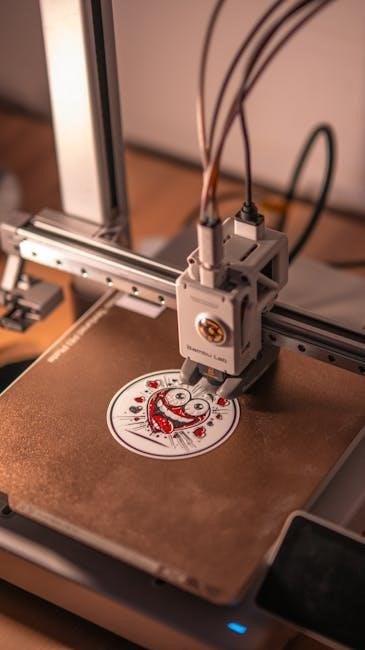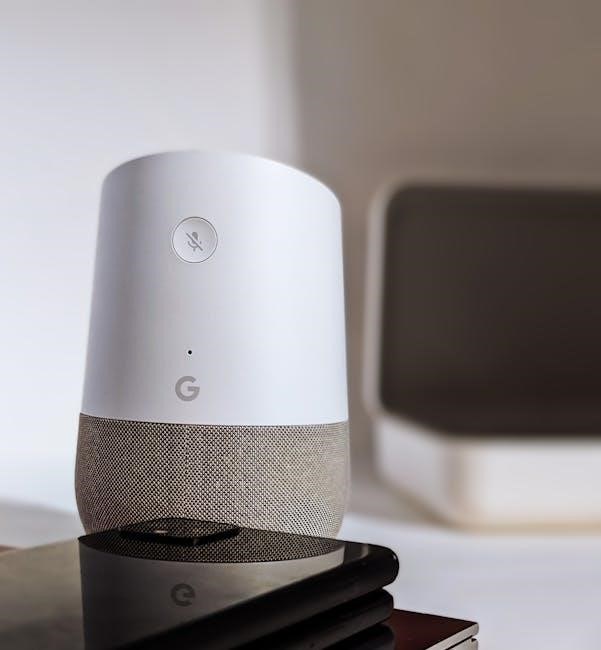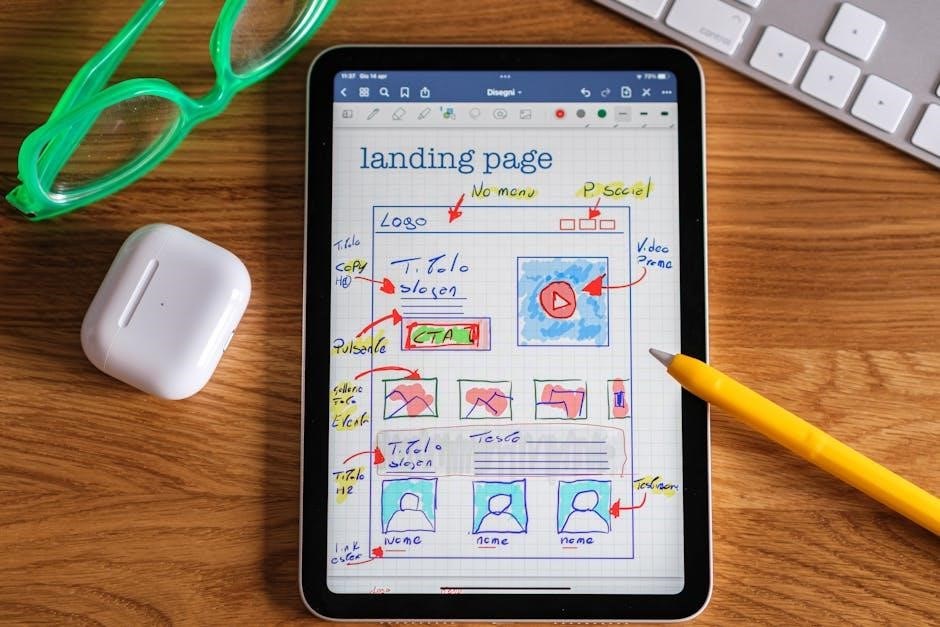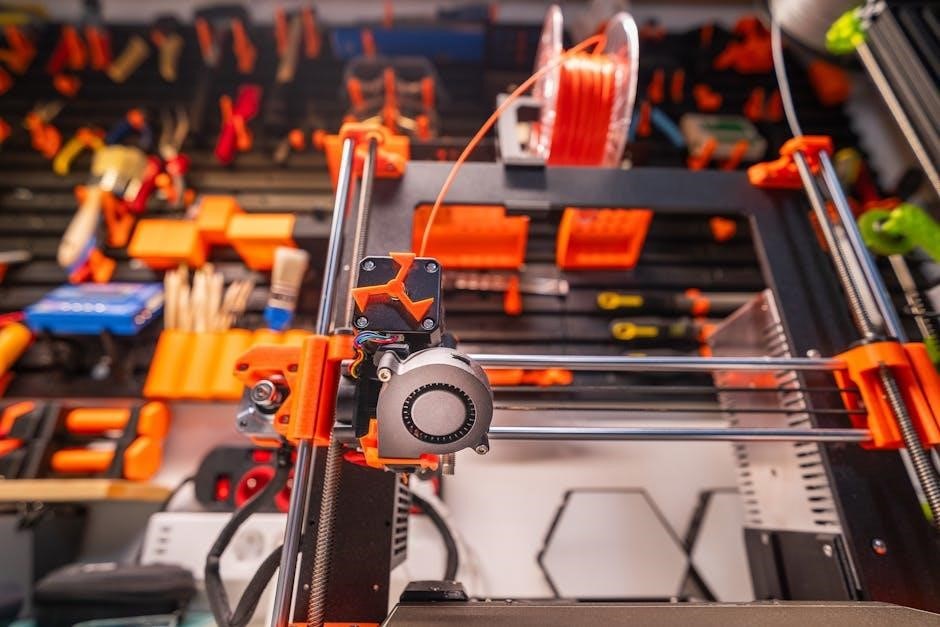Figma is a powerful cloud-based design tool enabling teams and individuals to create‚ collaborate‚ and prototype UI/UX designs in real-time. Its vector-based interface‚ prototyping features‚ and collaborative capabilities make it essential for modern design workflows.
1.1. What is Figma?
Figma is a cloud-based design and prototyping tool used for creating user interfaces and user experiences. It allows designers to craft vector-based designs‚ prototype interactions‚ and collaborate in real-time. Figma supports cross-platform access‚ enabling seamless teamwork and feedback sharing. Its intuitive interface and robust features make it a go-to solution for modern UI/UX design workflows‚ ensuring efficiency and creativity in bringing digital products to life.
1.2. Why Figma is a Popular Choice for Designers
Figma’s popularity stems from its real-time collaboration‚ cloud-based accessibility‚ and versatile design tools. Designers appreciate its seamless teamwork features‚ vector-based precision‚ and prototyping capabilities. The tool’s user-friendly interface and extensive plugin library enhance creativity and efficiency. Additionally‚ Figma’s cost-effective pricing and cross-platform compatibility make it a favorite among both professionals and newcomers in the UI/UX design community.
1.3. Key Features of Figma for UI/UX Design
Figma offers real-time collaboration‚ enabling teams to work simultaneously on designs. Its vector-based tools provide precision for creating scalable assets. The platform supports prototyping to bring designs to life with interactive elements. Reusable components and design systems streamline workflows. Figma also features plugins for extended functionality and responsive design capabilities to adapt layouts across devices. These features make Figma a comprehensive tool for efficient and collaborative UI/UX design processes.
Getting Started with Figma for Interface Design
Figma is a browser-based tool offering an intuitive interface for UI/UX design. Accessible via web or app‚ it enables real-time collaboration and seamless design prototyping workflows.
2.1. Downloading and Installing Figma
Figma is a free tool available for both web and desktop. Download the app for Windows or macOS from the official website. Ensure your system meets the requirements: Windows 10 or later‚ or macOS 10.13 or higher. No high-end hardware is needed. The desktop app provides offline access‚ while the browser version offers seamless collaboration. Install the software‚ sign in‚ and start designing. Automatic updates keep your app current with the latest features.
2.2. Setting Up Your First Figma Project

Launch Figma and click “Create New File” to start your first project. Choose a frame size or select “Custom” for flexibility. Use the toolbar to access basic tools like rectangles‚ text‚ and vectors. Organize your design by creating layers and pages for different sections. Utilize the Assets tab for reusable components. Take advantage of Figma’s intuitive interface to arrange elements and begin designing your interface or prototype with ease.
2.3. Navigating the Figma Interface
Figma’s interface is divided into key sections: the toolbar for design tools‚ the layers panel for organizing elements‚ and the properties panel for customizing objects. The assets tab stores reusable components‚ while the prototype tab enables interactivity. Use the canvas to design and the comments tool for feedback. Familiarize yourself with these areas to streamline your workflow and efficiently navigate while designing or prototyping in Figma.

Designing Interfaces in Figma
Figma empowers designers to craft intuitive interfaces with wireframes‚ mockups‚ and vector tools. Its responsive design features and collaborative capabilities streamline the creation of user-centric interfaces‚ enhancing productivity and creativity for designers.
3.1. Creating Wireframes and Mockups
Figma simplifies the creation of wireframes and mockups with its intuitive vector tools and collaborative features. Designers can quickly transition from concept to detailed design‚ leveraging Figma’s precision tools for accurate layouts. The platform supports the seamless creation of low-fidelity wireframes and high-fidelity mockups‚ enabling teams to refine ideas and iterate efficiently. Real-time collaboration ensures that everyone is aligned‚ making Figma an essential tool for streamlined interface design processes.
3.2. Using Figma’s Vector Tools for Precision Design
Figma’s vector tools offer precise control over shapes‚ paths‚ and text‚ enabling designers to craft intricate designs with accuracy. The pen tool‚ boolean operations‚ and smart selection features allow for complex vector manipulation. These tools are essential for creating scalable and responsive designs‚ ensuring consistency across different screen sizes. By utilizing Figma’s vector capabilities‚ designers can achieve professional-grade results efficiently‚ making it a cornerstone of modern UI/UX design workflows.
3.3. Implementing Responsive Design in Figma
Figma simplifies responsive design with its robust tools‚ allowing designers to create adaptable layouts for various screen sizes. Utilize auto-layout‚ grids‚ and constraints to ensure elements scale and align properly. Preview designs across multiple canvas sizes to test responsiveness. Figma’s vector-based approach ensures high-quality visuals at any resolution‚ making it easier to deliver consistent user experiences across devices. This ensures designs are future-proof and user-friendly.

Prototyping in Figma
Figma’s prototyping tools transform static designs into interactive experiences‚ enabling teams to collaborate in real-time and test app experiences before development begins.
Figma’s prototyping tools allow designers to create interactive experiences by linking screens and adding transitions. These tools bridge the gap between static designs and dynamic‚ testable prototypes‚ enabling teams to explore app flows and user interactions in real-time.
With features like hotspots and interactions‚ Figma simplifies the process of transforming wireframes into functional prototypes. This capability is crucial for testing designs before development‚ ensuring a seamless user experience and streamlining the design-to-development workflow.
4.2. Creating Interactive Prototypes
Interactive prototypes in Figma bring designs to life by simulating real-world user interactions. Designers can add hotspots and define interactions‚ enabling users to navigate through screens and experience the flow of an app or website. This feature allows teams to test and refine their designs dynamically‚ ensuring a polished and intuitive user experience before moving to development.
4.3. Testing and Refining Your Prototype
Testing your prototype in Figma allows you to gather feedback and identify areas for improvement. Use real-time collaboration to share your design with stakeholders and collect comments. Conduct user testing to observe how users interact with your design and pinpoint pain points. Iterate on your design by refining interactions‚ adjusting layouts‚ and ensuring a seamless user experience. This iterative process ensures your prototype meets both functional and aesthetic goals before development begins.

Collaboration and Feedback in Figma
Figma enables seamless real-time collaboration‚ allowing teams to work together on designs simultaneously. Share feedback directly within the tool‚ track changes‚ and manage iterations efficiently for better outcomes.
5.1. Real-Time Collaboration Features
Figma’s real-time collaboration allows multiple users to work on the same design file simultaneously. Changes are reflected instantly‚ enabling seamless teamwork. Users can leave comments and track modifications‚ fostering clear communication. The cloud-based platform ensures everyone is on the same page‚ eliminating version conflicts. This feature is particularly useful for remote teams‚ making it easier to align on design decisions and iterate quickly without delays.
5.2. Sharing and Receiving Feedback
Figma simplifies feedback collection by allowing users to share links to their designs. Viewers can leave comments directly on the canvas or specific elements. Designers can use @mentions to notify team members‚ ensuring timely responses. Feedback is organized in one place‚ making it easy to track and address. This streamlined process facilitates quick iterations and ensures designs align with stakeholder expectations before moving to development.
5.3. Managing Versions and Iterations
Figma’s version control allows designers to save multiple iterations of their work‚ making it easy to track changes over time. Users can create separate branches for experimental designs without affecting the main project. This feature ensures that previous versions are preserved‚ enabling quick rollbacks if needed. Additionally‚ version history provides a clear overview of modifications‚ facilitating collaboration and maintaining design integrity throughout the development process.

Exporting and Documenting Your Design
Figma allows seamless exporting of design assets in various formats for development. It also supports generating PDF documents and creating comprehensive design systems for consistency.
6.1. Exporting Assets for Development
Figma simplifies the process of exporting design assets by allowing users to download elements in multiple formats like PNG‚ SVG‚ and PDF. Designers can specify resolutions and naming conventions‚ ensuring assets are development-ready. This feature streamlines collaboration between designers and developers‚ making the handoff process efficient. Additionally‚ Figma’s cloud-based system ensures that exported assets are easily accessible to team members‚ maintaining consistency and reducing errors in the development phase.
6.2. Generating a PDF Document of Your Design
Figma allows users to export their designs as PDF files‚ making it easy to share and present work to stakeholders. By selecting specific frames or layers‚ designers can generate a PDF that captures the entire design or individual components. The export settings enable customization of layout‚ quality‚ and formatting‚ ensuring the final document meets presentation needs. This feature is particularly useful for creating design proposals‚ documentation‚ or client-ready materials that maintain design integrity and clarity.
6.3. Creating a Design System in Figma
Figma simplifies the creation of a design system by allowing the organization of reusable components‚ styles‚ and assets in a centralized library. Designers can establish consistent design standards across projects‚ ensuring uniformity and efficiency. By utilizing Figma’s component-driven approach‚ teams can easily maintain and update design assets‚ while also enabling collaboration and adherence to best practices. This fosters scalability and accelerates the design process‚ making it easier to manage complex projects.

Advanced Tips and Tricks for Figma
Master Figma’s shortcuts and leverage plugins to streamline your workflow. Utilize auto-layout for responsive designs and explore AI-powered tools for enhanced creativity and efficiency in your projects.
7.1. Using Plugins to Enhance Your Workflow
Plugins in Figma can significantly enhance your design process by adding custom functionality. Tools like SQUID 2.0 simplify user flow creation‚ while others offer advanced animation or design system capabilities. These extensions save time and streamline tasks‚ allowing you to focus on creativity. Install plugins directly from the Figma Plugin Directory to integrate them seamlessly into your workflow.
7.2. Mastering Figma’s Shortcuts and Keyboard Commands
Mastery of Figma’s keyboard shortcuts can drastically improve efficiency. Common commands like Ctrl+D for duplicating layers or Ctrl+G for grouping elements save time. Familiarize yourself with selection tools shortcuts like V for the move tool and A for frame selection. Additionally‚ shortcuts for prototyping such as Ctrl+Shift+E for interacting with prototypes streamline your workflow‚ enabling faster iteration and design refinement.
7.3. Optimizing Your Design Process
Optimizing your design process in Figma involves streamlining workflows and leveraging built-in features. Use grids and auto-layout for consistent designs‚ and adopt reusable components to save time. Organize files with clear naming conventions and tags for easy access. Additionally‚ utilize cloud collaboration to gather real-time feedback and iterate efficiently. Regularly clean up layers and assets to maintain a clutter-free workspace‚ ensuring a seamless and productive design experience.

Learning Resources and Tutorials
Explore free PDF guides and online courses to master Figma for UI/UX design. These resources provide step-by-step tutorials‚ covering everything from basics to advanced prototyping techniques and design systems.
8.1. Free Figma Tutorials and Guides
Discover a wealth of free Figma tutorials and guides available online‚ including downloadable PDF resources. These materials cover everything from basic interface design to advanced prototyping techniques; Resources like the “Newbies Guide to UI/UX Design Using Figma” offer comprehensive lessons for beginners. Additionally‚ Figma’s official website and community forums provide free tutorials and workshops‚ ensuring accessible learning for all skill levels. Start mastering Figma today with these invaluable resources.
8.2. Recommended PDF Resources for Figma
Enhance your Figma skills with recommended PDF resources like the “Figma Basics PDF (Extended Version)” and the “Figma Handbook”. These guides provide in-depth insights into interface design‚ prototyping‚ and collaborative workflows. The “Newbies Guide to UI/UX Design Using Figma” is another excellent resource‚ offering step-by-step tutorials for mastering Figma. These PDFs are ideal for both beginners and advanced users‚ ensuring comprehensive learning and practical application of Figma’s tools and features.
8.3. Online Courses for Advanced Learning
Advanced Figma courses offer in-depth training on user interface design‚ prototyping‚ and collaborative workflows. Platforms provide tutorials on mastering Figma’s tools‚ creating responsive designs‚ and leveraging vector-based design. Courses like “Figma Handbook” and “UI Design Fundamentals” offer comprehensive learning paths. Additionally‚ specialized courses on user flows and advanced prototyping help designers refine their skills‚ ensuring they stay up-to-date with Figma’s latest features and industry trends in UI/UX design.
Case Studies and Success Stories
Figma has been instrumental in transforming UI/UX design workflows for leading companies. Its real-time collaboration and prototyping tools have enabled teams to deliver seamless user experiences‚ driving project success and innovation across industries.
9.1. Real-World Applications of Figma
Figma is widely used across industries for UI/UX design‚ enabling teams to create responsive prototypes‚ brand assets‚ and interactive experiences. Its cloud-based collaboration simplifies workflows for global teams‚ while its vector tools and prototyping features support precise and scalable designs. Companies leverage Figma for web apps‚ mobile interfaces‚ and enterprise solutions‚ making it a cornerstone in modern design processes. Its versatility has made it indispensable for both startups and established organizations.
9;2. Success Stories from Leading Design Teams
Leading companies like Airbnb‚ Slack‚ and GitHub have successfully leveraged Figma for their design workflows. These teams highlight how Figma’s real-time collaboration and version control streamlined their processes‚ reducing feedback cycles and enhancing productivity. By utilizing Figma’s robust tools‚ they delivered intuitive user experiences and maintained consistent design systems. These success stories demonstrate Figma’s impact in driving innovation and efficiency in the design industry‚ making it a preferred choice for top-tier organizations.
9.3. Lessons Learned from Figma Projects

Design teams using Figma have learned the importance of organization and component libraries for maintaining consistency across large projects. Iterative testing and feedback loops have proven crucial for refining designs. Collaboration features have highlighted the need for clear communication to avoid version conflicts; These insights emphasize the value of structured workflows and continuous learning‚ enabling teams to deliver polished‚ user-centric designs efficiently while leveraging Figma’s robust capabilities.

The Future of Figma and UI/UX Design
Figma is revolutionizing UI/UX design with AI-driven tools‚ real-time collaboration‚ and cloud-based workflows‚ setting the standard for future design trends and innovation in the industry.
10.1. Emerging Trends in UI/UX Design
Emerging trends in UI/UX design include AI-driven design tools‚ real-time collaboration‚ and responsive design for seamless cross-device experiences. Micro-interactions and accessibility-focused designs are gaining prominence‚ enhancing user engagement and inclusivity. With Figma at the forefront‚ these trends are reshaping how designers create intuitive‚ dynamic‚ and user-centric interfaces‚ driving innovation in the digital landscape.
10;2. Upcoming Features in Figma
Figma has announced AI-powered design tools‚ enabling rapid site and web app creation. A new bulk asset generation feature for marketers and an advanced drawing tool are also upcoming. These updates aim to enhance real-time collaboration and streamline the design process. Additionally‚ improved responsive design capabilities and enhanced prototyping features are expected‚ further solidifying Figma’s position as a leader in UI/UX design.
10.3. The Role of AI in Figma’s Future
AI is set to revolutionize Figma by introducing AI-powered design assistants that can generate custom UI components and suggest optimizations based on user behavior. These tools will accelerate the design process‚ enabling faster iteration and refinement. AI-driven layout suggestions and automated workflows will also enhance collaboration‚ making it easier for teams to create intuitive and responsive designs. This integration ensures Figma remains at the forefront of UI/UX innovation.